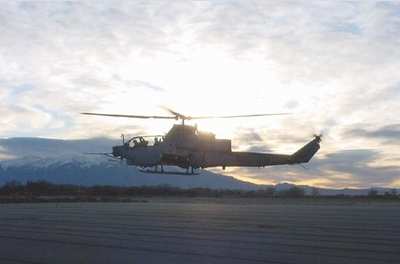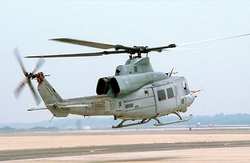 In a culmination of a busy month of flying,
at both Patuxent River (MD) and in the high desert
of Colorado, an all-Marine crew took the Corps’ newest
light/attack helicopters through the 1,000-hour mark recently.
In a culmination of a busy month of flying,
at both Patuxent River (MD) and in the high desert
of Colorado, an all-Marine crew took the Corps’ newest
light/attack helicopters through the 1,000-hour mark recently.
Flying a functional check of the Stability and Control
Augmentation Software in preparation for a test of the
UH-1Y’s Automatic Flight Control System, the crew of Maj. Pat
Lindauer, Maj. Dean Putnam and crew chief Sgt. Aaron Jameson rolled
the program into four digits to score the latest achievement for
the H-1 Upgrades program. Of five test aircraft, two (AH-1Z-1 and
UH-1Y-1) are currently flying high-altitude tests in Alamosa (CO).
While the others continue to achieve test objectives here,
according to program officials.

“Last month Z-3, and Y-2 both exceeded 30 flight hours for
the month, while Z-1 and Y-1 exceeded 20 flight hours,”
explained Robin H. Locksley, H-1 Upgrades Flight Test Team leader.
“These availability rates (of flight test aircraft) are an
excellent indicator of future performance, as the specification
only calls for planned availability of 25 flight hours per month.
During four of the last five months, the flight test team has
exceeded the number of planned test events and is on glide-slope to
exceed the planned events for May as well.”
Contributing to the overall achievement of the test team are the
individual milestones accrued by each of the test aircraft.
“Y-2 recently reached the 100 flight hour mark,”
Locksley continued. “Z-3 is projected to reach the 100 hour
mark this week. Z-1 will reach the 500-hour mark this week if the
weather is good in Alamosa.”

After more than 12 hours of cross country flying that included a
fly-by of the Bell plant in Texas where they were built, as well as
several over night stops, AH-1Z-1 and UH-1Y-1, arrived on the high
desert plateau of Western Colorado to begin high altitude testing
last week, according to Lt.Col. Nick Hall, Government Flight Test
director for the H-1 Integrated Test Team here.
Testing where high density altitudes exist closer to ground
level allows the team to test the aircraft’s performance and
handling close to the ground, but still where the air isn’t
as thick as at sea level, according to Hall. “With the field
elevation at 7,500 feet above sea level and favorable conditions
(low winds and warmer temperatures),” Hall explained,
“we can conduct hover performance both in and out of ground
effect, low airspeed sensor characterization and low airspeed
critical azimuth testing efficiently.”

Active duty Marines assigned to the test program here play a
pivotal role in each of the milestones achieved by the integrated
test team, which is comprised of both military and civilian members
representing the Marine Corps, Navy, civil service, contractor
support and Bell Helicopter.
“My maintenance Marines have done a phenomenal job,”
said Marine Capt. Jack Abate, H-1 Upgrades Maintenance Officer
here. “Gunnery Sgt Billy Potts, Staff Sgt Gregory Shaw, Sgt
Michael Montanez, and Cpl. Adam Phipps are currently supporting Z-1
in Alamosa, Colorado, two crew chiefs, Staff Sgt Eric Jazak and Sgt
Skylar Panter, flew in the back of Y-1 cross country to Alamosa and
will stay to support as a maintenance crew.
 “I also have Marines here who are involved
with all maintenance to get each bird on a flight schedule
everyday,” Abate explained. “In addition to these
duties they also perform reliability and maintainability tracking,
publication validation, maintenance procedure validation and
logistics verification. They are very interested and involved, and
with both developmental and operational test responsibilities they
keep busy.” In addition to turning wrenches and keeping the
aircraft available for tests, the Marines assigned to the team
provide a more important asset to the team – a
warfighter’s perspective.
“I also have Marines here who are involved
with all maintenance to get each bird on a flight schedule
everyday,” Abate explained. “In addition to these
duties they also perform reliability and maintainability tracking,
publication validation, maintenance procedure validation and
logistics verification. They are very interested and involved, and
with both developmental and operational test responsibilities they
keep busy.” In addition to turning wrenches and keeping the
aircraft available for tests, the Marines assigned to the team
provide a more important asset to the team – a
warfighter’s perspective.
“I am impressed with their insight and maturity when
making suggestions for solutions to known problems,” Abate
added. “The Marines also work closely with civilian
maintenance personnel and have made an excellent influence on them
also.” In addition to the Marines, the other members of the
team are proving the efficacy of the integrated team concept,
according to Locksley.
“The safe and efficient execution of this program is a
testament to the professionalism and attention to detail the
members of this team exhibit each and every day here in Hangar 109
and the engineering buildings, off site at Alamosa, and at the Bell
Plants down in Texas,” Locksley said. “This effort
would not be possible without the tireless efforts of the H-1
Upgrades integrated team of military, contractor, and civil service
professionals. Working shoulder to shoulder, this team will deliver
these aircraft out to the warfighters.”
 This
latest milestone, as well as the flights taking place in Colorado,
add to an already impressive lineage – H-1 aircraft have
totaled more than 27,000 flight hours since 1958 when the
“granddaddy” of all H-1’s, the HU-1, was
delivered. Since then, more than 16,000 H-1 helicopters have been
produced making it the most successful military aircraft in
aviation history.
This
latest milestone, as well as the flights taking place in Colorado,
add to an already impressive lineage – H-1 aircraft have
totaled more than 27,000 flight hours since 1958 when the
“granddaddy” of all H-1’s, the HU-1, was
delivered. Since then, more than 16,000 H-1 helicopters have been
produced making it the most successful military aircraft in
aviation history.
Remanufacture of the Marine Corps’ UH-1N and AH-1W
aircraft to the more than 80 percent identical UH-1Y and AH-1Z is
expected to save the Marine Corps approximately $3 Billion in
operating and support costs over the 30-year expected lifespan of
the aircraft. The UH-1Y and AH-1Z share a common drive train, rotor
head, tail boom, avionics, software and controls.
[ANN Thanks John C. Milliman, PMA-276 PAO]
 Senator Pushes FAA to Accelerate Rocket Launch Licensing
Senator Pushes FAA to Accelerate Rocket Launch Licensing Classic Aero-TV: RJ Gritter - Part of Aviations Bright New Future
Classic Aero-TV: RJ Gritter - Part of Aviations Bright New Future Aero-FAQ: Dave Juwel's Aviation Marketing Stories -- ITBOA BNITBOB
Aero-FAQ: Dave Juwel's Aviation Marketing Stories -- ITBOA BNITBOB ANN's Daily Aero-Linx (10.27.24)
ANN's Daily Aero-Linx (10.27.24) ANN's Daily Aero-Term (10.27.24): Clearance Void If Not Off By (Time)
ANN's Daily Aero-Term (10.27.24): Clearance Void If Not Off By (Time)








